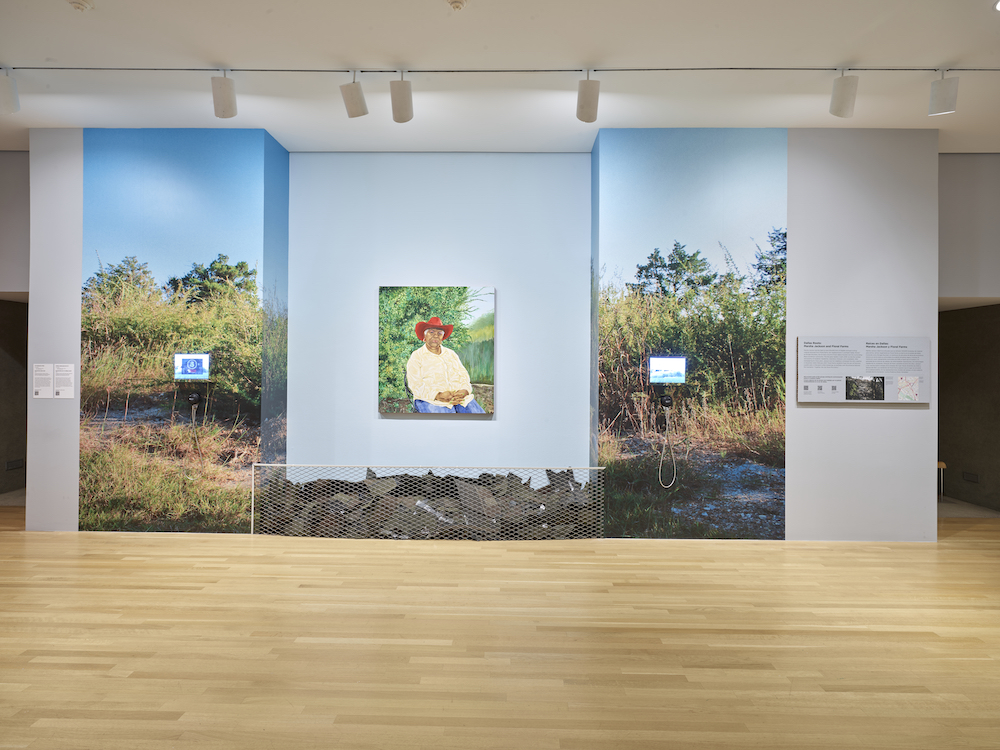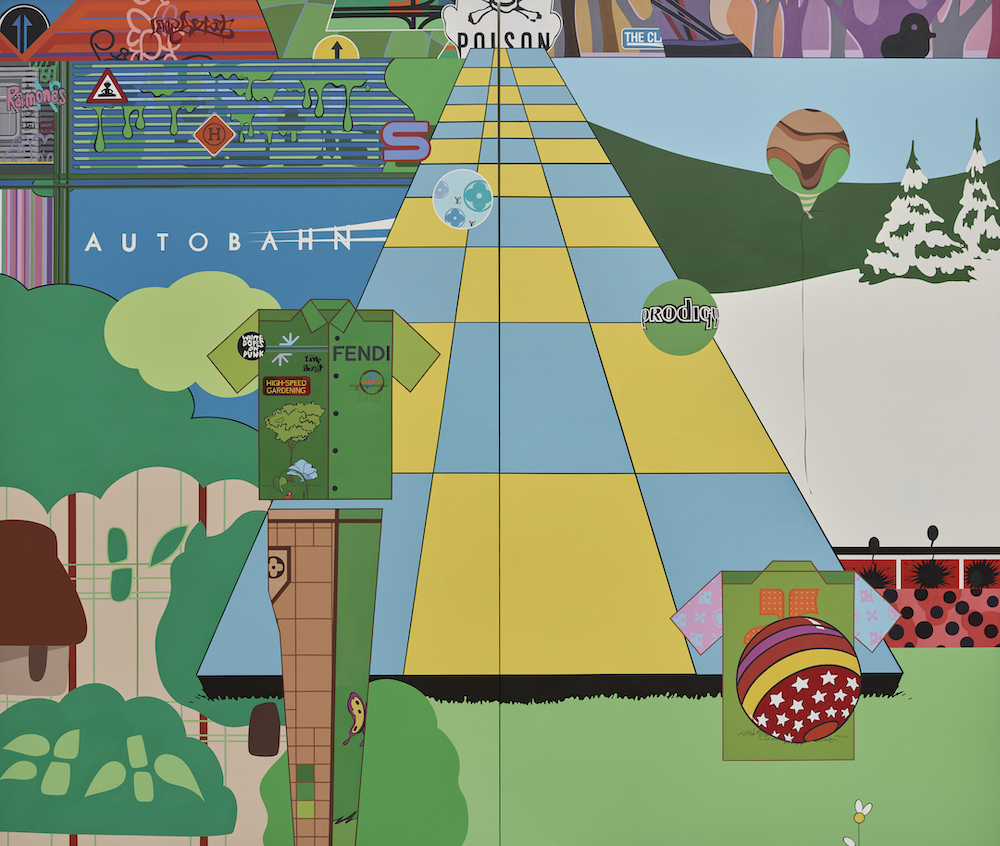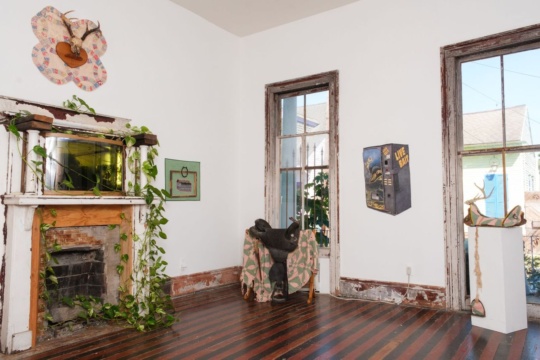
The first time that Marsha Jackson saw her portrait on display at the Dallas Museum of Art, she remembers thinking in shock, “That’s me, just a grandmother trying to fight for her health.”
In the portrait, Jackson is adorned by the greenery that she loves in her southern Dallas neighborhood, Floral Farms. She wears a bright red cowboy hat, a nod toward her daughter’s love of rodeo, and a long tradition of Black cowboy culture in Texas. Jackson’s fingernails are painted a striking lime green that plays off the foliage behind her.
For years, Jackson has been the face of a very public fight against Shingle Mountain, an illegal dump in the empty lot next to her house. A businessman seeking to undercut the costs of dumping roofing materials in the nearby city landfill created the dump in 2018, and it grew until a 6 story tall pile of shingles towered over Jackson’s and her neighbors’ houses. He evaded responsibility for cleaning up the dump, and it wasn’t until February 2021– nearly three years later– that the City of Dallas finally removed the mountain, after public pressure mounted to find money for the clean up. These days, Jackson dreams of building a park where Shingle Mountain once towered over her home. But that, too, will be an uphill battle: the debris left traces of lead in the soil beneath it, which must be cleaned up as well.
Jackson’s story is prominently featured in Rooted, a new group exhibition on view through April 9, 2023, at the Dallas Museum of Art. The exhibit showcases pieces exploring three key themes about nature and humans’ relationship to it: Adapt and transform; traverse and movement; and sustenance. Several of the works are by Texas artists from the museum’s permanent collection which have never been on display before. Rooted is part of the museum’s Center for Creative Connection, a more collaborative community-based exhibition series developed from community feedback and advisory partners. Arlington-based painter Ari Brielle created Jackson’s portrait as well as the temporary installation surrounding it. The only contemporary piece in the exhibit, Jackson’s portrait was commissioned by curators to bring present narratives of environmental justice into the fold. Jackson is thrilled by the painting, and the fact that her first portrait was painted by a young Black artist. When I ask her about the red cowboy hat and lime green nails she wears in the painting, she giggles with delight.
Brielle saw Jackson speak about Shingle Mountain a few years earlier at an event put on by a group called Dallas Truth, Racial Healing and Transformation. The image of Jackson standing in front of a projector screen with photos of Shingle Mountain stuck in her head. When the Museum put out a call for a commissioned work for Rooted, Brielle knew she wanted to paint Jackson– but without Shingle Mountain in the backdrop. “I didn’t want to center the mountain,” she says. “Something I think about a lot with my work is not centering our oppression as Black people.”
In the gallery, the portrait is the center of Brielle’s expanded installation Poisoned by Zipcode, perched over a pile of real shingles, held back by a net. They’ve begun to compress and flatten over time, and Brielle replenishes the pile with new shingles every so often to keep the effect going. On either side of the painting, interactive displays showcase video clips of protests about Shingle Mountain and photos taken by Brielle and environmental activists; another screen shows archival newspaper clippings about environmental justice issues that Brielle found while researching, like the lead smelter in West Dallas which poisoned a predominantly Latinx neighborhood. In 2020, a report by the same name from Paul Quinn College in Dallas found that people living in zip codes in southern Dallas– predominantly Black and communities of color– had higher exposure to air pollution than those in wealthier, whiter zip codes in the city’s north.
When the portrait is eventually taken down from the museum’s walls, the vestiges of Brielle’s recreation of Shingle Mountain will be discarded. “To me, the installation is site-specific, and one day, it won’t exist,” she says. “But portraits have been made throughout history and they are this very permanent manifestation of a person. [Jackson’s] portrait should stand alone as this incredible person that she is, not this thing that happened to her.”

Curators at the museum began planning Rooted well before the COVID-19 pandemic, and before the video of a police officer killing George Floyd sparked protests across the nation that summer. As businesses shut down and governors across the country issued stay-at-home orders, green spaces became a solace and refuge for millions of Americans. But not all Americans had the same access to those spaces, or even clean, healthy environments in their own neighborhoods. Rooted was designed to visually trace environmental history in Dallas, from open prairie to sprawling megacity, and show how, along the way, the role of nature in people’s lives was often irrevocably altered.
“We had an abundance of artwork that spoke to Dallas in earlier days, and we could use those to pivot and talk about Dallas today,” Emily Schilling, the museum’s senior manager of interpretation says. “Providing narratives of environmental justice and racism wasn’t, I think, highly difficult because the collection is really strong– we have a strength in Texas art and specifically, with Texas regionalism from the 30s and 40s.” In the “adapt and transform” segment of Rooted, two paintings offer diverging views of Dallas: On the right, a 1932 painting by Lloyd Sargent offers a view of a bustling downtown block. On the left, in Charles Bowling’s 1941 Winter Evening, a lone figure walks through a dimly lit street towards a dark, weary house with skyscrapers peeking out behind them.
The contrast between the two scenes is striking: The color pallets of Sargent’s South Akard Street are warm and inviting, while Bowling offers a more somber scene. The viewer may guess that one of these scenes is supposed to represent a more desirable vision of Dallas than the other. The panel of text accompanying the two pieces draws these experiences views of the city, perhaps a bit heavy handedly – a QR code directs viewers to a report on redlining. The connection between the three elements—two works of art, and the accompanying context—were influenced by conversations that curators had with community advisory groups, says Claire Moore, the Center for Creative Connections’ education director.

“With the breadth of perspectives in our advisory group, there were so many stories that directly connected with the themes we were investigating in the works of art,” says Claire Moore, “So, folks from the Dallas Mexican American Historic League were talking about gentrification, and changing to zoning that had transformed communities.”
Another cluster of paintings in the “traverse” section of the exhibit focuses on transportation: A painting of highway road signs by Coreen Mary Spellman, a North Texas artist and Michael Bevilacqua’s pop-culture rendition of the Autobahn highway in Germany are paired with information about the Texas Department of Transportation’s proposal for a highway expansion project in downtown Dallas. The city’s highways were built through Black neighborhoods in the 50s, decimating communities and deepening racial and economic segregation along a north-south divide. Community activists, residents and urban planners have built a growing campaign to demolish an elevated freeway that cuts off the city’s art districts from surrounding neighborhoods.
Neither painting – both by white artists–quite manages to capture the fraught history of America’s highway building spree. A third painting, by the African American folk artist Willard Watson, shows the artists’ recollection of the cityscape: cattle runs, railroads, and the Magnolia Petroleum building, at the time the tallest in the city. But the connection between Watson’s work and the explanatory text about highways feels tenuous at best. In fact, viewers who aren’t familiar with Watson might not realize that as a child in the 1930s, the artist fled to Dallas to escape plantation sharecropping in Louisiana. Moments like this feel like a missed attempt at meaningfully engaging art from or by communities of color alongside the narratives of contemporary struggles for equity.
DMA has also benefited from such shifts in thinking around the built environment. In 2012, city leaders partnered with the state and private donors to build a deck park directly across from the museum’s entrance. Where there was once a gaping chasm offering views of a busy, congested highway, Klyde Warren Park provides greenery, shade and a bustling streetscape for pedestrians. But those far removed from the glamor of the city’s arts district have not benefitted from such projects. Here, predominantly Black and Latinx communities are fighting off new concrete plants that would create hazardous pollution next to homes and schools, or finding grants from universities to conduct their own air monitoring. And for her part, Jackson is worried that a new industrial site will appear overnight in the lot next to her house. It’s still zoned for industrial use, after all, despite her pleas to the city.
Rooted is on view at the Dallas Museum of Art through April 9.




